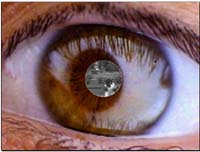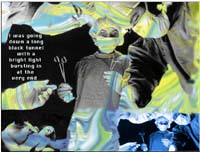


 |
 |
 |
Biography
|
Christine Tamblyn is a conceptual artist who operates
interchangeably in the realms of image production and cultural criticism.
Her videotapes and performances have been presented nationally at the
Kitchen and Anthology Film Archives in New York, the Detroit Institute
of Arts, LACE and the Woman's Building in Los Angeles, NAME Gallery in
Chicago and Sushi in San Diego. In the Bay Area, her work has been featured
at S. F. Camerawork, Southern Exposure Gallery, the Eye Gallery and San
Francisco Cinematheque. Tamblyn has been making electronic art and writing
cultural criticism since 1974. Her critical articles and reviews have
been published in many art magazines and academic journals, including
Art News, Afterimage, Leonardo, High Performance, exposure and the College
Art Association Journal. Her articles on feminist performance and video
have been anthologized in Illuminating Video (Aperture Press), in Yesterday
and Tomorrow: California Women's Art (Midmarch Press) in Feminist Criticisms
2 (Harper/Collins) and in Resolutions 2 (University of Minnesota Press).
Tamblyn is an Assistant Professor of Visual Arts at University of California,
Irvine. She has also taught at the University of California, Berkeley,
Mills College in Oakland, the School of Visual Arts in New York, the University
of California at Santa Cruz, San Francisco State University and Florida
International University. Her performative lectures have been presented
at many professional conferences: the Society for Photographic Education
National Conference, the College Art Association National Conference,
the National Alliance of Media Art Centers Conference and the American
Film Institute National Video Festival. She was the recipient of the John
McCarron Art Writing Award from Artspace in San Francisco in 1987 and
1990. Tamblyn's first CDROM, "She Loves It, She Loves It Not: Women and
Technology was shown in "Seduced and Abandoned: The Body in the Virtual
World" at the Institute of Contemporary Arts in London; at Pacific Film
Archives at the University Art Museum in Berkeley; at "The Illustrated
Woman" conference held at the Yerba Buena Center for the Arts in San Francisco;
at the San Francisco Exploratorium; at the Wexner Center for Contemporary
Art in Columbus, Ohio; at the Ansel Adams Center for Photography in San
Francisco; at the "Digital Identities" conference at the University of
Nevada, Reno; at the Walter Phillips Gallery in the Banff Centre in Alberta,
Canada; at SIGGRAPH '94 in Orlando, Florida; at the Australian International
Video Art Symposium in Sydney, Australia: at ISEA '94 in Helsinki, Finland;
in "ARS 95" at the Museum of Contemporary Art in Helsinki, Finland; at
the Huntington Art Center in Huntington Beach, California; at Centro Cultural
Caixavigo in Vigo, Spain; at "Cyborg Festival," De Balie, The Netherlands,
Amsterdam and at the Art Gallery of New South Wales in Sydney, Australia
among other venues. "Mistaken Identities", Tamblyn's second CDROM, premiered
in a one person exhibition at the International Center for Photography
in New York from March 29 to June 2, 1996. It was also shown at the First
International Video Festival in Buenos Aires November 22-26, 1995, at
the Mediopolis Videofest in Berlin February 15-25, 1996, at the 14th World
Wide Video Festival in The Hague, The Netherlands from April 26-30, 1996,
at "Moveable Feast: Camerawork's Inaugural Exhibition," in San Francisco,
California from May 3 - June 15, 1996, at the University Art Museum, Miami,
Florida from June 14-August 10, 1996, at SIGGRAPH '96 in New Orleans,
Louisiana from July 8 - August 10, 1996, at the Brisbane Film Festival
in Brisbane, Australia, from August 1-10, 1996, at the Dallas Video Festival
in Dallas, Texas, from January 9-12, 1997, at "Techno-Seduction," Cooper
Union, New York, New York, from January 15-February 28, 1997, at the University
Art Museum in Berkeley, California from March 1-31, 1997 and at the National
Museum of Women in the Arts in Washington, D. C. from May 29-31, 1997.
It won a Finalist Award at the 1996 New York Exposition of Short Film
and Video, an Honorable Mention in the1996 "New Voices, New Visions" contest
sponsored by Wired magazine, Interval Corporatiion and Voyager Corporation,
and First Prize in the 1997 International Festival of the Image, Universidad
de Caldas, Manizales, Colombia. Tamblyn received a National Endowment
for the Arts Commission to produce a new CDROM, "Archival Quality," in
1997.
|
Conceptual Description
|
As as operator in the arena of "conceptual art," I have
decided to frame my art practice within the cultural context of art criticism.
I believe that the critic is a collaborator with the artist, participating
in the creation of a work of art by influencing the way viewers receive
and interpret it. Not merely a parasitic vampire, the critic deserves
credit as an auteur of the art works she discusses, if these art works
are seen as open texts that begin at their physical boundaries rather
than stopping there. Appropriating ideas as malleable material, the postmodern
critic can experiment with the format and style of criticism she employs.
She can blend literary genres, interpolating criticism and personal narrative,
or criticism and epistolary writing. Or, she can pen mimetic criticism,
emulating the style of the artist whose work she is examining. As an exemplary
spectator, the critic oscillates androgynously between male and female
genders. I see the artist not primarily as an imagemaker, but rather as
a facilitator of dialogue. Thus, it is difficult to specifically locate
the work that I do; my work is responsive to specific occasions or sets
of circumstances. What I have tried to do in this statement is to describe
some of these situations, and how I have intervened in them. These examples
do not constitute an exhaustive inventory of my work, which by its refusal
of notions of essential form also resists packaging and encapsulization.
--Christine Tamblyn
|